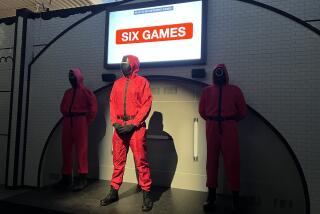The Player: ‘Galak-Z’ is hard to decode, but the trying is fun
Some of the best games — and some of the most difficult — create their own language.
It’s a dialect borne out of patterns, of habits and of good ol’ fashioned trial and error. They speak in code.
Their digital renderings are passed from generation to generation — interactive signifiers of where to go, what to avoid and how to slay. Staying out of space lava may be the obvious thing to do, but what about those gelatinous bubbles that slurp out of the rocks? Maybe those are good? Maybe they’re healing? After all, they make a goopy sound that’s slightly comforting when my spaceship passes through them, so they must be good, right?
No, turns out they’re not healing. But at least another piece of “Galak-Z’s” speech patterns were unraveled.
“Galak-Z” is certainly difficult, and it’s also quite good. Its dialect reveals itself patiently, and it often contradicts itself.
The hectic action on-screen is at odds with the measured, subtle gracefulness with which the game controller must be handled.
Force won’t work. While these are space battles that can be over in a flash, my spaceship drifts, spins and dances as if in a weightlessness vacuum. The challenge: To read the game, one must try to view it in slow motion and adjust accordingly. Tap rather than press. Lean rather than direct.
SIGN UP for the free Indie Focus movies newsletter >>
After spending three days with the game, “Galak-Z’s” vintage, outer-space vernacular remains something of a mystery. It was more than a day before I could confidently take down what the game refers to as “bugs” — seemingly robot-like space creatures — but “Galak-Z’s” language was starting to come into view.
With each bumpy, floating journey through an asteroid field, more strategies took shape. When a space monster shot out of a crater to gobble up an enemy rather than the faithful player-controlled hero, A-Tak, whole new lines of attack suddenly revealed themselves.
Thus, this familiar-but-alien universe, one modeled after late 1970s and early ‘80s cartoons, gradually started to feel not so foreign. The key to early success in “Galak-Z” — I won’t pretend that I’ve come close to finishing it — is simple: slow down.
It’s advice that is at odds with the urgency of the game. Die once, and more or less all is lost. You will start at the beginning of the most recent “season” you accomplished. Each season — the game is modeled like a television series — is five episodes.
An hour or two of progress can be lost in a second, and yet with each failure “Galak-Z” constantly informs the player that there are more paths to victory. Maybe, for instance, don’t always shoot. Maybe I could lure the bugs closer to my enemies. Maybe I can twirl around luminescent rocks until I’ve led various space factions into a war with each other, allowing myself swift escape.
A swift escape into more bugs. Maybe I could try to trick the bugs into jettisoning into the aforementioned must-avoid space lava.
Or maybe I could in fact simply try to gun it out, boosting my ship’s power just when the metal-ish claws of the bug spring forth and then firing lasers to keep the bug at bay. There will, if all goes according to plan, be yellow bug guts.
There were probably other paths, but they likely wouldn’t go according to plan and the outcome would most definitely be the same: death.
Learning the language of a new game is part of the puzzle, but it can also be overwhelming, as I discovered the first time — nay, the first dozen times — “Galak-Z” asked me to obliterate 40-plus bugs.
This is excruciatingly tough. “Bloodborne,” earlier this year, left me scarred and scared. Ten hours, a few things killed, and that was it for me. The game won. White flag. “Galak-Z,” I’m not throwing in the towel yet. It’s tricky, but it goes out of its way to temper the frustration.
Maybe it’s the lighthearted tone. Maybe it’s the fact that, at first, “Galak-Z” looks just a tad like a modern take on “Asteroids.” I know where this is going, you think. Blast blast blast blast blast. Dead.
A few suicide runs later and, no, you don’t know where this is going, but by then it’s too late.
There’s just enough retro-appeal for the game to feel accessible rather than daunting, mystifying rather than nostalgic. Our excited hero, A-Tak, charms with his “Speed Racer” style. The characters he meets have their own flair — a reggae-loving, mostly trustworthy mechanic, or a seen-it-all-before combat veteran who gives A-Tak his missions. Her humorous lack of faith reassures by conveying there’s nothing left to lose, even when A-Tak’s ship unexpectedly transforms into a giant, more powerful robot.
But I’m mostly sticking around for the drift. “Galak-Z,” developed by Seattle-born 17-Bit, which previously released the well-received strategy title “Skulls of the Shogun,” wants you to get lost in space rather than rocket through it.
Eight to 10 hours in, and I think I’m starting to speak “Galak-Z’s” language: Death will come suddenly, so maybe don’t waste a lifetime fighting it.
Twitter: @Toddmartens
------------
‘Galak-Z’
Developer/publisher: 17-Bit
Platforms: PlayStation 4 (available now), PC (coming soon)
Price: $19.99
------------
MORE:
Geeks are the new overlords. Great. Now can we get over ourselves?
In the indie game ‘N++’ you get only one life -- and time is ticking
Nintendo’s President Satoru Iwata was always willing to take a risk
More to Read
The biggest entertainment stories
Get our big stories about Hollywood, film, television, music, arts, culture and more right in your inbox as soon as they publish.
You may occasionally receive promotional content from the Los Angeles Times.







